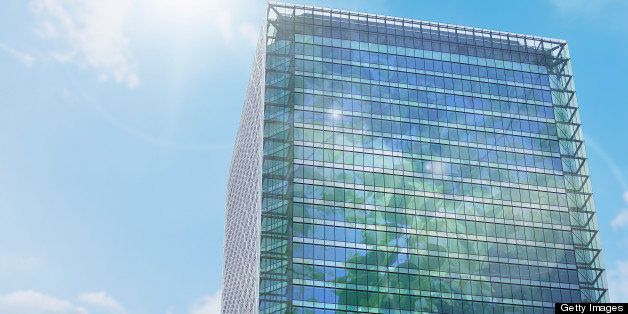
The green building industry has the right idea; they're just doing it backwards.
In order to move sustainable building design and operations to the mainstream, green certifications systems should learn an important lesson from President Obama -- competition can be the foundation for social good. It's not that crazy, 40 of 50 states have bought into the Race to the Top initiative for education improvement, and the administration's 2014 budget even proposes a Race to the Top Initiative for utility grid modernization.
By far the most popular green building certification, the LEED Rating System, has had enormous success since its inception in 1998. LEED stands for Leadership in Energy and Environmental Design; and it certainly is a leader -- 1.5 million square feet of real estate become LEED certified daily and more than $100 billion worth of commercial and residential buildings now hosts a LEED plaque.
These stats are impressive, but is the LEED Rating System having the maximum impact? Is it appealing to the greatest number of building owners while maintaining tough standards? Is it achieving the scale needed to tackle our urgent environmental challenges?
Throughout the program's history, critics in the construction industry have argued (with merit) that certification is too expensive, too complicated, and requires too much paperwork. In response, the United States Green Building Council (USGBC) has released updated versions that streamline the process, a focus evident in the newest iteration, LEED V4, set to release later this year.
The Good System
For those unfamiliar with how green building certifications work, it is a lot like the standardized testing from "No Child Left Behind" that "Race to the Top" was intended to replace in federal education funding.
Basically, there are five credit categories, covering different environmental issue areas: site management, water efficiency, energy efficiency, indoor air quality, and material conservation. Each category has a variety of credits that can be achieved by implementing an environmental conservation measure or meeting a defined threshold of a sustainability metric, such as the percent of building materials that were locally extracted. These credits are added up to determine which level of LEED Certification the building project achieves -- Certified, Silver, Gold or Platinum.
The problem with this is that credits are achieved by reaching a lowest threshold, not by pushing the boundaries of sustainability and incentivizing innovation. To put it another way, building projects seeking LEED Certification are told exactly what is good enough, and as the saying goes -- Good is the enemy of Great. Perhaps this is why the most common level of certification is Gold; nobody can get mad at a "B" grade, especially if everyone gets a "B."
A Great System
A great system would be a relative competition amongst all buildings that apply for LEED Certification. Imagine if only 15 percent of all LEED buildings could be awarded as Gold at any time, and annual reporting on the various metrics could move a project's level up or down. Imagine if instead of prescribing methods for sustainability, like installing bike racks, the USGBC simply defined a metric, like fuel burned for transportation, and allowed innovation and competition to unlock the best methodologies and practices. Imagine if building occupants were incentivized to learn about and utilize the features of their building in order to maintain (or improve) the building's rating, and even become a LEED Green Associate themselves. Imagine the media attention that would be generated from such a profound change.
Why Not?
A lot of time and resources have been spent building LEED into what it is today. Its growth is a testament to its success, and it's hard to argue with success. Still, given that buildings account for 38 percent of the greenhouse gas emissions in the United States, the scale of the problems we face requires solutions at a scale that is unachievable in the current system.
Some will say that the differences in climate and building types will hinder direct competition. Others will say that competition will scare away new entrants and anger incumbents. More will say that fluctuating awards will be too confusing or logistically difficult.
I say that all this is welcome. If it's easier to conserve resources in New York, or Tokyo, or São Paulo, then those who build in those areas should be rewarded with higher levels of certification. Likewise, if a project in a hot rural area can figure out how to overcome the inherent disadvantages, it would create a template for other projects in similar regions around the world.
To the second point, competition is nothing new to the construction industry; instead of scaring away newcomers, it will be a way for traditional firms to prove their superiority in a new market. Instead of angering incumbents, it will be a way for them to prove that they achieved what they set out to do. Only those who have used LEED to "greenwash" (by cherry-picking easy credits) and take advantage of tax incentives would be against this change.
Logistically, the shift away from prescriptive standards development to verifying and comparing metrics will also free resources within the USGBC to award and notify LEED projects on an annual basis. It could even lower the costs and headache of applying for certification by reducing the application length.
Just like Race to the Top looked to address the poor incentive program in federal education funding, the USGBC needs to recognize that only by incentivizing competition, can LEED truly achieve the scale needed to combat our pressing environmental issues. Fortunately, the heavy lifting of defining environmental issues as quantifiable metrics and making the LEED brand a force in the industry has already been accomplished.
The next couple years will determine a lot about the state of our environment and economy for the next century; this is just one of the many bold concepts that need to be considered if we are to have a legitimate chance at long term prosperity.